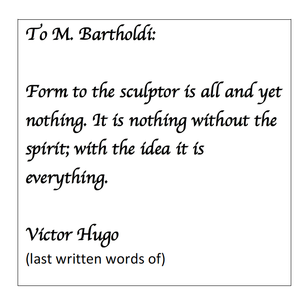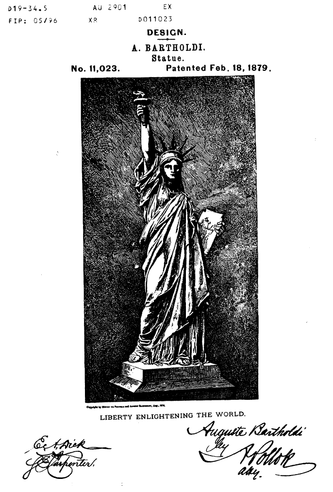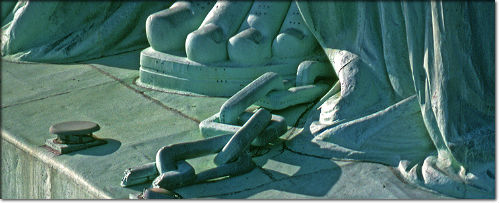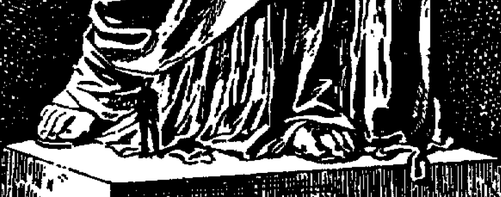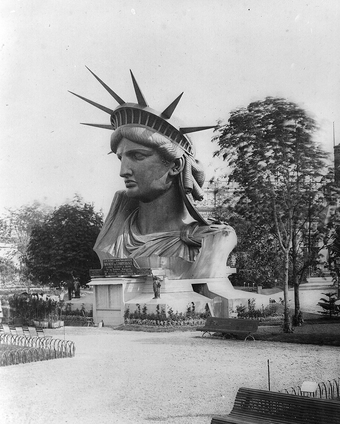 Paris Universal Exhibition
Paris Universal Exhibition
On February 18 of the year 1879, U.S. Design Patent No. 11,023 issued to Frédéric Auguste Bartholdi for a statue entitled "Liberty Enlightening the World". Today, the statue is better known as the "Statue of Liberty".
Contrary to prevailing myth, the Liberty statue was not a gift of friendship from the country of France to the United States. Rather, it was the result of a single-minded quest by Bartholdi to build a colossal sculpture that would rival the magnificent works of antiquity. He worked relentlessly to raise awareness and support for his project, enlisting the help of prominent figures of the day, such as Victor Hugo, Ulysses S. Grant and, most importantly, Joseph Pullitzer.
Bartholdi also engaged in all sorts of endeavors to raise funds for the construction of the Liberty statue. In 1876, Bartholdi displayed the hand and torch of the Liberty statue at the World's Fair in Philadelphia and charged admission for visitors to climb up to the balcony surrounding the torch. In a similar venture, Bartholdi displayed the head of the Liberty statue at the Paris Universal Exhibition of 1878. Although he couldn't directly charge admission for visitors to enter the head, Bartholdi found a way to do so indirectly.
At both the World's Fair and the Paris Universal Exhibition, Bartholdi sold souvenirs depicting the Liberty statue, including busts, badges and photographs. In order to deter competition in the sale of souvenirs, Bartholdi obtained a copyright registration for the statue in August of 1876, a design patent (U.S. Design Patent No. 10,893) for the head and shoulders of the statue in November of 1878 and then the '023 design patent for the entire statue.
Ultimately, it was Pulitzer that enabled sufficient funds to be raised to construct the Liberty statue. In addition to supporting the project in his newspaper, the New York World, with editorials and cartoons, Pullitzer started a fund for the project. In order to spur donations to the fund, he printed the name of every person in the World who contributed to the fund, no matter how small the contribution was. This was a clever marketing strategy because in addition to raising a significant amount of money for the project, Pullitzer increased the sales of the World due to people wanting to see their name in print.
In addition to being faced with the problem of raising funds for the Liberty statue, Bartholdi was also presented with the issue of securing a location for the statue and figuring out a way to support it. Bartholdi successfully persuaded President Grant to work with Congress to permit the Liberty statue to be constructed on Bedloe's island in New York Harbor. However, there was one proviso. The Liberty statue had to operate as a lighthouse, which never happened.
With regard to the issue of supporting the Liberty statue, Bartholdi successfully persuaded the brilliant Gustave Eiffel (of Eiffel tower fame) to design an interior structure for supporting the statue. The interior structure included an iron truss skeleton connected to a center pylon so as to permit small relative movement between the two. The copper skin of the statue was also loosely connected to the skeleton to permit the skin to move relative to the skeleton. With this construction, the statue could move slightly in the winds of New York Harbor and the outer skin could expand and contract in response to changes in temperature. By permitting such movement, stress on the statue was greatly reduced, thereby avoiding cracking of the outer skin.
The Liberty statue was finally completed and dedicated in October of 1886. As finally constructed, the statue differed somewhat from what Bartholdi had originally envisioned, as evidenced by the filing for his copyright registration. One of the submitted drawings was an artistic rendering of how the statue would look upon completion. In this rendering, the statue is shown holding in her left hand, a broken chain and shackle, symbolizing freedom. Bartholdi would later replace the chain and shackle with a tablet inscribed "July IV, MDCCLXXVI". Bartholdi, however, did not completely dispense with the symbolic broken chain. He discretely placed the broken chain next to the left foot of the statue. While not visible to tourists, the broken chain can be seen in the photograph below.
A close inspection of the drawing for the '023 design patent reveals the broken chain and another odd feature. At the bottom of Liberty's gown, toward the right foot, a small human figure can be seen. Perhaps, this human figure represents Bartholdi himself, admiring his timeless work of art.
Contrary to prevailing myth, the Liberty statue was not a gift of friendship from the country of France to the United States. Rather, it was the result of a single-minded quest by Bartholdi to build a colossal sculpture that would rival the magnificent works of antiquity. He worked relentlessly to raise awareness and support for his project, enlisting the help of prominent figures of the day, such as Victor Hugo, Ulysses S. Grant and, most importantly, Joseph Pullitzer.
Bartholdi also engaged in all sorts of endeavors to raise funds for the construction of the Liberty statue. In 1876, Bartholdi displayed the hand and torch of the Liberty statue at the World's Fair in Philadelphia and charged admission for visitors to climb up to the balcony surrounding the torch. In a similar venture, Bartholdi displayed the head of the Liberty statue at the Paris Universal Exhibition of 1878. Although he couldn't directly charge admission for visitors to enter the head, Bartholdi found a way to do so indirectly.
At both the World's Fair and the Paris Universal Exhibition, Bartholdi sold souvenirs depicting the Liberty statue, including busts, badges and photographs. In order to deter competition in the sale of souvenirs, Bartholdi obtained a copyright registration for the statue in August of 1876, a design patent (U.S. Design Patent No. 10,893) for the head and shoulders of the statue in November of 1878 and then the '023 design patent for the entire statue.
Ultimately, it was Pulitzer that enabled sufficient funds to be raised to construct the Liberty statue. In addition to supporting the project in his newspaper, the New York World, with editorials and cartoons, Pullitzer started a fund for the project. In order to spur donations to the fund, he printed the name of every person in the World who contributed to the fund, no matter how small the contribution was. This was a clever marketing strategy because in addition to raising a significant amount of money for the project, Pullitzer increased the sales of the World due to people wanting to see their name in print.
In addition to being faced with the problem of raising funds for the Liberty statue, Bartholdi was also presented with the issue of securing a location for the statue and figuring out a way to support it. Bartholdi successfully persuaded President Grant to work with Congress to permit the Liberty statue to be constructed on Bedloe's island in New York Harbor. However, there was one proviso. The Liberty statue had to operate as a lighthouse, which never happened.
With regard to the issue of supporting the Liberty statue, Bartholdi successfully persuaded the brilliant Gustave Eiffel (of Eiffel tower fame) to design an interior structure for supporting the statue. The interior structure included an iron truss skeleton connected to a center pylon so as to permit small relative movement between the two. The copper skin of the statue was also loosely connected to the skeleton to permit the skin to move relative to the skeleton. With this construction, the statue could move slightly in the winds of New York Harbor and the outer skin could expand and contract in response to changes in temperature. By permitting such movement, stress on the statue was greatly reduced, thereby avoiding cracking of the outer skin.
The Liberty statue was finally completed and dedicated in October of 1886. As finally constructed, the statue differed somewhat from what Bartholdi had originally envisioned, as evidenced by the filing for his copyright registration. One of the submitted drawings was an artistic rendering of how the statue would look upon completion. In this rendering, the statue is shown holding in her left hand, a broken chain and shackle, symbolizing freedom. Bartholdi would later replace the chain and shackle with a tablet inscribed "July IV, MDCCLXXVI". Bartholdi, however, did not completely dispense with the symbolic broken chain. He discretely placed the broken chain next to the left foot of the statue. While not visible to tourists, the broken chain can be seen in the photograph below.
A close inspection of the drawing for the '023 design patent reveals the broken chain and another odd feature. At the bottom of Liberty's gown, toward the right foot, a small human figure can be seen. Perhaps, this human figure represents Bartholdi himself, admiring his timeless work of art.
Proudly powered by Weebly



